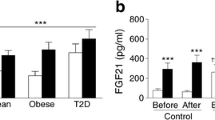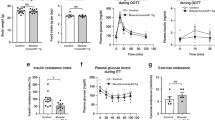Abstract
Aerobic exercise, including treadmill running has been widely used to treat insulin resistance and type 2 diabetes. We studied the effects of endurance training on gene expression of adiponectin receptor 1 (AdipoR1) in skeletal muscle of obese Zucker rats: the 8-week moderate exercise program consisted of treadmill running at 20 m/min and 0° gradient for 1 h/day, 7 days/week. After 8 weeks, insulin action on glucose disposal rate was measured by glucose–insulin index, the product of the areas under the curve of glucose and insulin during intraperitoneal glucose tolerance testing. In contrast to results for sedentary obese rats, exercise training decreased plasma levels of insulin and glucose as well as the glucose–insulin index in obese rats, indicating the merit of regular moderate exercise for improvement of insulin sensitivity in this insulin-resistant animal model. Also, diabetes-related reductions in mRNA and protein content of AdipoR1 in soleus muscle were observed in obese rats at baseline; they were markedly reversed after the 8-week exercise program. However, such exercise training did not alter plasma levels of insulin and glucose in lean Zucker rats. Also, AdipoR1 gene expression in soleus muscle was not changed by exercise in lean Zucker rats compared with the sedentary, lean littermates. These results suggest that long-term exercise training may reverse reduced AdipoR1 gene expression in soleus muscle and improve insulin sensitivity in the obese Zucker rats. Thus, an endurance exercise training is probably helpful clinically for obese individuals with insulin resistance.


Similar content being viewed by others
References
Ahren B, Pacini G (2004) Importance of quantifying insulin secretion in relation to insulin sensitivity to accurately assess beta cell function in clinical studies. Eur J Endocrinol 150:97–104
Altomonte J, Harbaran S, Richter A, Dong H (2003) Fat depot–specific expression of adiponectin is impaired in Zucker fatty rats. Metabolism 52:958–963
Arita Y, Kihara S, Ouchi N, Takahashi M, Maeda K, Miyagawa J, Hotta K, Shimomura I, Nakamura T, Miyaoka K et al (1999) Paradoxical decrease of an adipose-specific protein, adiponectin, in obesity. Biochem Biophys Res Commun 257:79–83
Bassuk SS, Manson JE (2005) Epidemiological evidence for the role of physical activity in reducing risk of type 2 diabetes and cardiovascular disease. J Appl Physiol 99:1193–1204
Brozinick JT Jr, Etgen GJ Jr, Yaspelkis BB 3rd, Ivy JL (1993) Effects of exercise training on muscle GLUT-4 protein content and translocation in obese Zucker rats. Am J Physiol 265:E419–E427
Combs TP, Berg AH, Rajala MW, Klebanov S, Iyengar P, Jimenez-Chillaron JC, Patti ME, Klein SL, Weinstein RS, Scherer PE (2003) Sexual differentiation, pregnancy, calorie restriction, and aging affect the adipocyte-specific secretory protein adiponectin. Diabetes 52:268–276
Cox KL, Burke V, Morton AR, Beilin LJ, Puddey IB (2004) Independent and additive effects of energy restriction and exercise on glucose and insulin concentrations in sedentary overweight men. Am J Clin Nutr 80:308–316
Davies KJ, Quintanilha AT, Brooks GA, Packer L (1982) Free radicals and tissue damage produced by exercise. Biochem Biophys Res Commun 107:1198–1205
Haslam DW, James WP (2005) Obesity. Lancet 366:1197–1209
Henriksen EJ (2002) Invited review: effects of acute exercise and exercise training on insulin resistance. J Appl Physiol 93:788–796
Hotta K, Funahashi T, Arita Y, Takahashi M, Matsuda M, Okamoto Y, Iwahashi H, Kuriyama H, Ouchi N, Maeda K, Nishida M, Kihara S, Sakai N, Nakajima T, Hasegawa K, Muraguchi M, Ohmoto Y, Nakamura T, Yamashita S, Hanafusa T, Matsuzawa Y (2000) Plasma concentrations of a novel, adipose-specific protein, adiponectin, in type 2 diabetic patients. Arterioscler Thromb Vasc Biol 20:1595–1599
Hotta K, Funahashi T, Bodkin NL, Ortmeyer HK, Arita Y, Hansen BC, Matsuzawa Y (2001) Circulating concentrations of the adipocyte protein adiponectin are decreased in parallel with reduced insulin sensitivity during the progression to type 2 diabetes in rhesus monkeys. Diabetes 50:1126–1133
Hu E, Liang P, Spiegelman BM (1996) AdipoQ is a novel adipose-specific gene dysregulated in obesity. J Biol Chem 271:10697–10703
James DE, Jenkins AB, Kraegen EW (1985) Heterogeneity of insulin action in individual muscles in vivo: euglycemic clamp studies in rats. Am J Physiol 248:E567–E574
Kasiske BL, O’Donnell MP, Keane WF (1992) The Zucker rat model of obesity, insulin resistance, hyperlipidemia, and renal injury. Hypertension 19:I110–I115
Kimura M, Tateishi N, Shiota T, Yoshie F, Yamauchi H, Suzuki M, Shibasaki T (2004) Long-term exercise down-regulates leptin receptor mRNA in the arcuate nucleus. Neuroreport 15:713–716
Kingwell BA, Formosa M, Muhlmann M, Bradley SJ, McConell GK (2002) Nitric oxide synthase inhibition reduces glucose uptake during exercise in individuals with type 2 diabetes more than in control subjects. Diabetes 51:2572–2580
Liu TP, Liu IM, Cheng JT (2005) Improvement of insulin resistance by panax ginseng in fructose-rich chow-fed rats. Horm Metab Res 37:146–151
Maeda N, Takahashi M, Funahashi T, Kihara S, Nishizawa H, Kishida K, Nagaretani H, Matsuda M, Komuro R, Ouchi N, Kuriyama H, Hotta K, Nakamura T, Shimomura I, Matsuzawa Y (2001) PPARgamma ligands increase expression and plasma concentrations of adiponectin, an adipose-derived protein. Diabetes 50:2094–2099
Milan G, Granzotto M, Scarda A, Calcagno A, Pagano C, Federspil G, Vettor R (2002) Resistin and adiponectin expression in visceral fat of obese rats: effect of weight loss. Obes Res 10:1095–1103
Nagasaki M, Nakai N, Oshida Y, Li Z, Xu M, Obayashi M, Murakami T, Yoshimura A, Fujitsuka N, Shimomura Y, Sato Y (2000) Exercise training prevents maturation-induced decreases in insulin receptor substrate-1 and phosphatidylinositol 3-kinase in rat skeletal muscle. Metabolism 49:954–959
Nakai N, Miyazaki Y, Sato Y, Oshida Y, Nagasaki M, Tanaka M, Nakashima K, Shimomura Y (2002) Exercise training increases the activity of pyruvate dehydrogenase complex in skeletal muscle of diabetic rats. Endocr J 49:547–554
Nara M, Kanda T, Tsukui S, Inukai T, Shimomura Y, Inoue S, Kobayashi I (1999) Running exercise increases tumor necrosis factor-alpha secreting from mesenteric fat in insulin-resistant rats. Life Sci 65:237–244
Punyadeera C, Zorenc AH, Koopman R, McAinch AJ, Smit E, Manders R, Keizer HA, Cameron-Smith D, van Loon LJ (2005) The effects of exercise and adipose tissue lipolysis on plasma adiponectin concentration and adiponectin receptor expression in human skeletal muscle. Eur J Endocrinol 152:427–436
Rajala MW, Scherer PE (2003) Mini review: the adipocyte-at the crossroads of energy homeostasis, inflammation, and atherosclerosis. Endocrinology 144:3765–3773
Saengsirisuwan V, Perez FR, Kinnick TR, Henriksen EJ (2002) Effects of exercise training and antioxidant R-ALA on glucose transport in insulin-sensitive rat skeletal muscle. J Appl Physiol 92:50–58
Sakamoto K, Goodyear LJ (2002) Exercise effects on muscle insulin signaling and action. Invited review: intracellular signaling in contracting skeletal muscle. J Appl Physiol 93:369–383
Scherer PE, Williams S, Fogliano M, Baldini G., Lodish HF (1995) A novel serum protein similar to C1q, produced exclusively in adipocytes. J Biol Chem 270:26746–26749
Schinner S, Scherbaum WA, Bornstein SR, Barthel A (2005) Molecular mechanisms of insulin resistance. Diabet Med 22:674–682
Stumvoll M, Goldstein BJ, van Haeften TW (2005) Type 2 diabetes: principles of pathogenesis and therapy. Lancet 365:1333–1346
Su CF, Chang YY, Pai HH, Liu IM, Lo CY, Cheng JT (2005) Mediation of beta-endorphin in exercise-induced improvement in insulin resistance in obese Zucker rats. Diabetes Metab Res Rev 21:175–182
Tofovic SP, Jackson EK (2003) Rat models of the metabolic syndrome. Methods Mol Med 86:29–46
Tsuchida A, Yamauchi T, Ito Y, Hada Y, Maki T, Takekawa S, Kamon J, Kobayashi M, Suzuki R, Hara K, Kubota N, Terauchi Y, Froguel P, Nakae J, Kasuga M, Accili D, Tobe K, Ueki K, Nagai R, Kadowaki T (2004) Insulin/Foxo1 pathway regulates expression levels of adiponectin receptors and adiponectin sensitivity. J Biol Chem 279:30817–30822
Yamauchi T, Kamon J, Minokoshi Y, Ito Y, Waki H, Uchida S, Yamashita S, Noda M, Kita S, Ueki K, Eto K, Akanuma Y, Froguel P, Foufelle F, Ferre P, Carling D, Kimura S, Nagai R, Kahn BB, Kadowaki T (2002) Adiponectin stimulates glucose utilization and fatty-acid oxidation by activating AMP-activated protein kinase. Nat Med 8:1288–1295
Yamauchi T, Kamon J, Ito Y, Tsuchida A, Yokomizo T, Kita S, Sugiyama T, Miyagishi M, Hara K, Tsunoda M, Murakami K, Ohteki T, Uchida S, Takekawa S, Waki H, Tsuno NH, Shibata Y, Terauchi Y, Froguel P, Tobe K, Koyasu S, Taira K, Kitamura T, Shimizu T, Nagai R, Kadowaki T (2003a) Cloning of adiponectin receptors that mediate antidiabetic metabolic effects. Nature 423:762–769
Yamauchi T, Kamon J, Waki H, Imai Y, Shimozawa N, Hioki K, Uchida S, Ito Y, Takakuwa K, Matsui J, Takata M, Eto K, Terauchi Y, Komeda K, Tsunoda M, Murakami K, Ohnishi Y, Naitoh T, Yamamura K, Ueyama Y, Froguel P, Kimura S, Nagai R, Kadowaki T (2003b) Globular adiponectin protected ob/ob mice from diabetes and ApoE-deficient mice from atherosclerosis. J Biol Chem 278:2461–2468
Yatagai T, Nishida Y, Nagasaka S, Nakamura T, Tokuyama K, Shindo M, Tanaka H, Ishibashi S (2003) Relationship between exercise training-induced increase in insulin sensitivity and adiponectinemia in healthy men. Endocr J 50:233–238
Yokoyama H, Emoto M, Araki T, Fujiwara S, Motoyama K, Morioka T, Koyama H, Shoji T, Okuno Y, Nishizawa Y (2004) Effect of aerobic exercise on plasma adiponectin levels and insulin resistance in type 2 diabetes. Diabetes Care 27:1756–1758
Acknowledgments
We appreciate Miss M.Y. Chen for her kind assistance in the blotting analysis. The present study was supported in part by a grant from the National Science Council (NSC 93-2320-B-006-010) of Taiwan, Republic of China.
Author information
Authors and Affiliations
Corresponding author
Rights and permissions
About this article
Cite this article
Chang, SP., Chen, YH., Chang, WC. et al. Increase of adiponectin receptor gene expression by physical exercise in soleus muscle of obese Zucker rats . Eur J Appl Physiol 97, 189–195 (2006). https://doi.org/10.1007/s00421-006-0163-3
Accepted:
Published:
Issue Date:
DOI: https://doi.org/10.1007/s00421-006-0163-3




